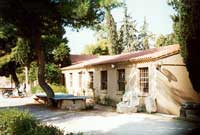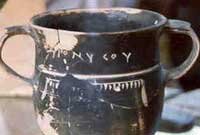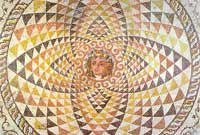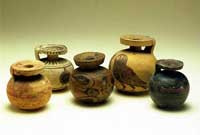 |
| The
museum was built in 1931/32 by the architect W. Stuart Thompson and was
extended towards the east in 1950. It contains collections of
prehistoric finds, various items ranging from the Geometric to the
Hellenistic period, Roman and Byzantine finds, excavation finds from the
Asklepieion of Corinth, and a collection of sculptures and inscriptions. |
|
 |
|
The
most important items of the exhibition are:
Large Mycenaean krater
decorated with a painted representation of warriors on a chariot. Dated
to 1200 B.C.
|
|
 |
|
Corinthian amphora with a lid. It bears a representation of two heraldic cocks and a double palmette at the center. Dated to ca. 600 B.C.
Corinthian aryballos bearing a representation of six dancers and an inscription reading: dancer Myreias leads the chorus. Dated to ca. 580 B.C.
|
|
Marble
sphinx from a funerary monument.
It is resting on the hind legs and standing on the fore. Traces of
painted decoration are preserved on the torso and the wings. Corinthian
product, dated to the middle of the 6th century B.C. |
|
Mosaic,
pebbled floor, with a
representation of griffins devouring a horse. It is one of the earliest
preserved Greek mosaics, dated to ca. 400 B.C.
Terracotta imitations
of human parts. A group of
terracotta parts of the human body in natural size (hands, legs,
genitals etc.). Votive offerings from the Asklepieion of Corinth, dated
to the 4th century B.C.
|
|
 |
|
Marble statue of a youth. Roman
portrait, possibly of Lucius Caesar, son of Augustus, dated to the end
of the 1st century B.C. or the beginning of the 1st century A.D. It
imitates a Greek original of the first half of the 4th century B.C.
|
|
 |
|
Statues
of barbarian slaves. Two marble,
larger than life statues, representing barbarian slaves. They decorated
the pillars with Corinthian capitals which supported the roof of the
"Facade of the Captives", a two-storeyed stoa to the west of
the Propylaia. Dated to the 2nd century A.D.
|
|
Mosaic floor
decorated with the head of Dionysos framed by ornaments. It comes from a Roman villa and dates to the 2nd century A.D.
Byzantine glazed
plate. It is decorated with a
representation of Digenis Acritas and a princess, and dates from the
12th century A.D. It belongs to a series of imported Byzantine vases,
spanning the period from the end of the 9th until the end of the 14th
century A.D.
|
|
|
 |
|
|
|